I know, pregnancy is a tough time… You had nausea, reflux and now your pelvis hurts! Stop 2min and think about what happens inside your belly, it is normal to feel different. All your body is changing right now!
Let’s see together what you can do to fight this pain and enjoy the end of your pregnancy.
#1 Sciatica position
Sciatica and low back pain are very common pain at some stage of pregnancy. It starts to hurt inside your buttock or your lower back and day after day (sometimes even hours after hours), pain is coming down in your leg.
If you are lucky, pain is on and off. But, it also can be there all along the day and stop you to move around.
Fortunately, there is simple exercise, which will release the pain:
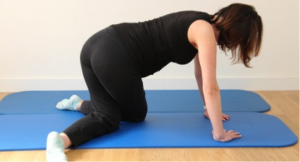
Start on all fours with legs crossed
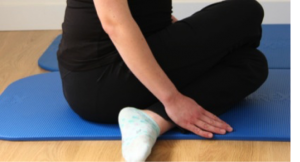
And gently sit down. Hold this position for 30-45 seconds and repeat as many times as you need to feel the releasing.
#2 Pelvis releasing
If you don’t identify the kind of pain you are suffering from, but you feel uncomfortable around your pelvis area, try this position:

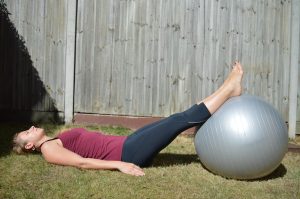
Lie on the floor and put your feet on a swiss ball. Bring gently your legs on right side, come back in the middle and do the same on the other side.
Stay 2-3minutes in this position.
Light legs and free pelvis for the rest of the day!
#3 Stretching
I know, you already aware you should stretch! I just want to give you the 3 “must do” stretching.
1.Piriformis
I hear you “What is this muscle?” It is the one inside your gluteus (buttock). It is a small muscle but very important all along pregnancy as it support your pelvis. However, for the same reason, it becomes very stiff and traps your sciatic nerve, leading to sciatica or low back pain.
To stretch it:
- Lie on your back,
- Bend your knees and bring one ankle on the opposite knee.
- Then take this knee with both hands and bring it to your chest (You should feel a stretch in your buttock)
- Maintain for 20s
- Do the same on the other side
- Repeat twice
.
Posterior muscle chain
The posterior chain is a training term that refers to the muscles of your back body, including the muscles of your lower back, gluts, hamstrings and calves. As your baby is growing up in your belly and your pelvis is moving, your muscles are more and more tight.
Simple way to stretch all these muscles together:
- Lie on the floor, put a small pillow under your head, bring your legs against a wall.
- Wrap a yoga strap or Theraband (or an old tie or belt from your bathrobe) around the ball of your feet.
- Use the strap to pull your toes toward your head while breathing out.
- Hold for 30-60 seconds
Or both legs together:
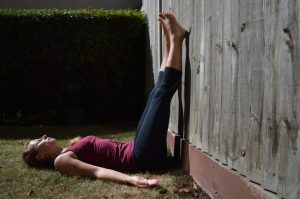
Adductor muscles
They are located on the inside of the thigh including the groin. These muscles stabilize the pelvis when baby is growing.
- Sit on the floor with your knees apart and the bottom of your feet together.
- Keep your chest up and your back straight.
- Bend forward at the hips while accentuating your lumbar lordosis (keep pelvis tilted anteriorly)
- Apply gentle pressure to your knees pushing them toward the floor.
- Relax and hold this for the appropriate time.
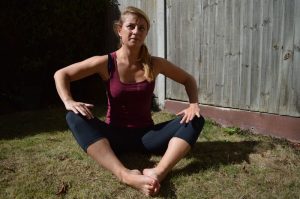
#4 Squat on heels
Squat on heels increases fluidity in the hips, and stretches the ankles, knees, and lower back. It also strengthens the core muscles. This pose is so effective for opening the hips that it’s the position most women use to give birth.
Squat on your heels. If they don’t reach the floor, use a book to support them.
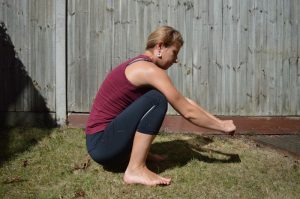
#5 How to move around
When your pelvis or your lower back hurt, it is not easy to stand up from a lying position. Here are some advices to help you to manage it!
First, from back to side:
– Put a pillow between your legs to avoid opening your legs
– Turn as a whole on your side (trunk and hips together)
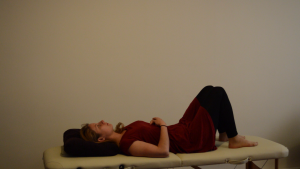
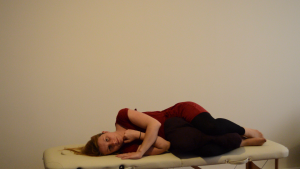
Then to sit up:
– Take both of your legs together out of the bed
– Use your arms to sit up
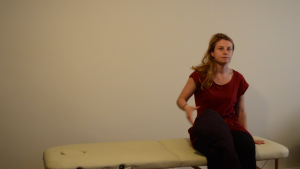
Finally, to stand up: bend forward and put your hands on you laps to help you and open your legs
#6 Proprioceptive exercises (balance exercises)
These exercises aim to keep a good balance as pregnancy has a very negative effect on it. And a bad balance leads to pelvis pain…
Choose the most difficult level you are able to hold for 10 sec:
1st level: Stand on one leg with knee straight
2nd level: Stand on one leg with knee straight and eyes closed
3rd level: Stand on one leg with knee bend and eyes opened
4th level: Stand on 1 leg with knee bend and eyes closed
#7 pelvic belt
I wrote an article about it (for more details), but I really advice you to wear a pregnancy belt to protect your pelvis, your lower back and your pelvic floor



